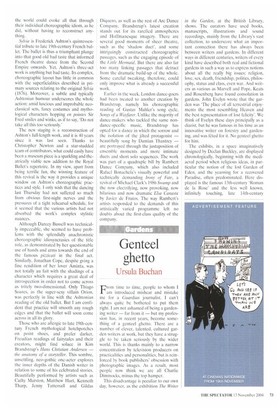Past master
Giannandrea Poesio
Sylvia Royal Ballet, Royal Opera House Hans Christian Andersen the anatomy of a storyteller Are Dance COIYIptIlIy. Linbuiy Studio Theatre Rambert Dance Company Sadler:s Wells Theatre
The lack of great dance-makers that
he contemporary dance has prompted a number of reconstructions of long-lost ballets, often with questionable results. It is utterly refreshing, therefore, to see how Frederick Ashton could evoke the past without getting entangled in an artistically sterile quest for authenticity. Few people in the history of ballet had his deep understanding of past styles, practices and atmospheres. And few people in
the world could evoke all that through their individual choreographic idiom, as he did, without having to reconstruct anything.
Sylvia is Frederick Ashton's quintessential tribute to late 19th-century French ballet. The ballet is thus a triumphant plunge into that good old had taste that informed French theatre dance from the Second Empire onwards. Yet, Ashton's three-act work is anything but bad taste. Its complex, choreographic layout has little in common with the superficialities described in primary sources relating to the original Sylvia (1876). Moreover, a subtle and typically Ashtonian humour underscores the whole action; amid luscious and improbable neoclassical sets, fancy costumes and mythological characters hopping en pointes Sir Fred smiles and winks, as if to say, 'Do not take all this too seriously.'
The new staging is a reconstruction of Ashton's full-length work, and it is 40 years since it was last seen. Thanks to Christopher Newton and a star-studded team of contributors, what could easily have been a museum piece is a sparkling and theatrically viable new addition to the Royal Ballet's repertoire. In my view, apart from being terrific fun, the winning feature of this revival is the way it provides a unique window on Ashton's choreographic practices and style. I only wish that the dancing last Thursday had not suffered so much from obvious first-night nerves and the pressures of a tight rehearsal schedule, for it seemed that the various artists had not absorbed the work's complex stylistic nuances.
Although Darcey Busse11 was technically impeccable, she seemed to have problems with the splendidly anachronistic choreographic idiosyncrasies of the title role, as demonstrated by her questionable use of hands and arms towards the end of the famous pizzicati in the final act. Similarly, Jonathan Cope, despite gving a fine rendition of her lover Aminta, was not totally au fait with the shadings of a character which requires a great deal of introspection in order not to come across as tritely two-dimensional. Only Thiago Soares, as the super-sexy villain Orion, was perfectly in line with the Ashtonian reading of the old ballet. But I am confident that practice will smooth any rough edges and that the ballet will soon come across in all its glory.
Those who are allergic to late 19th-century French mythological hotchpotches on point shoes, and prefer darker, Freudian readings of fairytales and their creators, might find solace in Kim Brandstrup's Hans Christian Andersen — the anatomy of a storyteller. This sombre, unsettling, neo-gothic one-acter explores the inner depths of the Danish writer in relation to some of his celebrated stories, Beautifully performed by artists such as Cathy Marston, Matthew Hart, Kenneth Tharp, Jenny Tattersall and Gildas Diquero, as well as the rest of Arc Dance Company, Brandstrup's latest creation stands out for its rarefied atmospheres and Hoffmanesque imagery. There are several good moments of sheer theatre, such as the 'shadow duet', and some intriguingly constructed choreographic passages, such as the engaging episode of the Little Mermaid. But there are also far too many linking passages that detract from the dramatic build-up of the whole. Some careful tweaking, therefore, could only improve what is already a successful work.
Earlier in the week, London dance-goers had been treated to another creation by Brandstrup, namely his choreographic reading of Gustav Mahler's song cycle, Songs of a Wayfarer. Unlike the majority of dance-makers who tackled the same nondance-specific music, Branclstrup has opted for a dance in which the sorrow and the isolation of the jilted protagonist — beautifully sung by Damian Thantrey — are portrayed through the juxtaposition of ensemble moments and more intimate duets and short solo sequences. The work was part of a quadruple bill by Rambert Dance Company, which also included Rafael Bonachela's visually powerful and technically demanding Irony of Fate, a revival of Michael Clark's 1986 Swamp and the now electrifying, now provoking, now hilarious and now dramatic Elsa Canasta by Javier de Frutos. The way Rambert's artists responded to the demands of this artistically varied programme left no doubts about the first-class quality of the company.



























































































 Previous page
Previous page